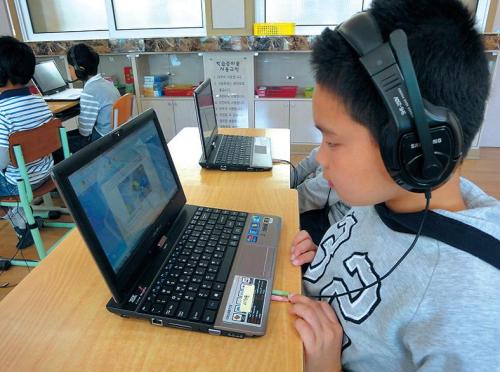But challenges lie ahead of full rollout of e-textbooks in 2015
Sosu Elementary School in rural Goesan, North Chungcheong Province, recently received eight students transferred from other schools. It was a rare moment for the school, which usually has more students leaving than coming in.
“The change came after we were designated two years ago as a pilot school to use digital textbooks,” said headmaster Jo Yong-deuk.
Sosu Elementary is among the 63 schools nationwide designated to employ digital textbooks before all schools adopt them in 2015 under the Education Ministry’s “smart education” initiative.
The hi-tech drive has changed Sosu Elementary inside and out, the headmaster said.
“It’s not just a simple matter of adopting digital textbooks.”
Classrooms are now equipped with wireless Internet connections, which allows interactive learning between students and teachers and helps the school communicate better with parents, Jo explained.
Digital gadgets in classrooms are expected to fundamentally change the way students are taught.
Teachers expect digital education tools to enable self-directed learning, an ideal but elusive goal in the current education environment. Self-directed learners will not simply follow what teachers tell them to do, but search for information and knowledge about what interests them.
 |
A student at Sosu Elementary School looks at a computer screen in a class using digital textbooks.(Sosu Elementary School) |
Currently, in most Korean schools below college level, teachers take full control of the class, preparing students to get high scores in exams.
“Students will transcend borders and share different experiences through ‘smart education’ that can build their communication and collaboration skills, which are key qualities to have in the future,” said Kim Jin-sook, director of smart education R&D division of the Korea Education and Research Information Service. KERIS is in charge of implementing the government’s “smart education” strategies.
“They are more important than getting good scores on mathematics or English,” she said.
She described what schools will look like in the future. Students will use digital textbooks available with any digital device and cloud computing. Teachers will use electronic whiteboards. Classrooms will be installed with wireless Internet so that they can send and receive files easily. Attendance, saved on student ID cards, will be checked automatically and sent to parents. The ID cards will also contain students’ health and other information so that dieticians can know whether they are allergic to certain foods, for example.
Sosu Elementary School plans to use QR codes, a bar-code-like technology, to send school information and notices to parents. QR codes are printed squares of jumbled black spots. When a smartphone equipped with a free QR code app points the phone’s camera at the image, it links directly to a website with more information.
“It all starts with digital textbooks. They’re not restricted to content only, but will upgrade the whole school system and education to a new level,” said Jo.
Challenges ahead
There are challenges to be overcome before all students can study with digital textbooks in 2015.
“We are working on the frame of smart education. For example, we are examining whether digital textbooks should be applied to all grades and all subjects,” said Kim.
“Some people oppose the idea that all students study all subjects with digital textbooks.”
She said that experts call into question the educational effectiveness of digital textbooks for students in first or second grade at elementary school. They say first and second graders need more “real life” experiences.
Experts are also concerned that young students will become hooked on digital devices.
At the first schools opened in Sejong City, the new administrative city in South Chungcheong Province, students from fourth grade up are issued tablet PCs.
Ra Eun-jong, an Education Ministry official in charge of digital textbook development, said the government would set guidelines this month on from what grade and in which subjects to use digital textbooks.
Other questions under consideration include whether all subjects are fit for digital education.
“We need to consider carefully whether every subject is suitable for digital learning methods,” Kim said.
Social science is currently the most digitally taught subject.
According to a KERIS survey of 357 teachers conducted from September to December last year, 28 percent taught social science with digital books only.
English and mathematics were the two least digitally taught, with 14 and 16.7 percent of teachers adopting digital tools, respectively.
As each subject requires different teaching methods, digital textbooks cannot be adopted for all classes, teachers say.
So, the Education Ministry plans not to scrap all existing paper textbooks. Experts note the need to build an effective teaching model regarding digital textbooks.
The ministry began to train teachers in smart education last year, with focus on how to use digital devices.
“The training focused on how to use digital devices because teachers are not comfortable yet with them,” said Ki Soo-deok, a teacher at Incheon Dongmak Elementary School.
Ra said the government is working on effective teaching models in relation to digital textbooks.
Digital textbooks also require a revision of laws on traditional education.
School law and textbook law are open to disputes over digital textbooks, a KERIS report said. It cited definition and characteristics as the first issues to be resolved regarding the status and copyright of digital textbooks.
Headmaster Jo of Sosu Elementary pointed to a more practical problem.
“Tablets are so expensive. Furthermore, when one breaks down, it takes about 15 days to get it fixed.”
By Lee Woo-young (
wylee@heraldcorp.com)








